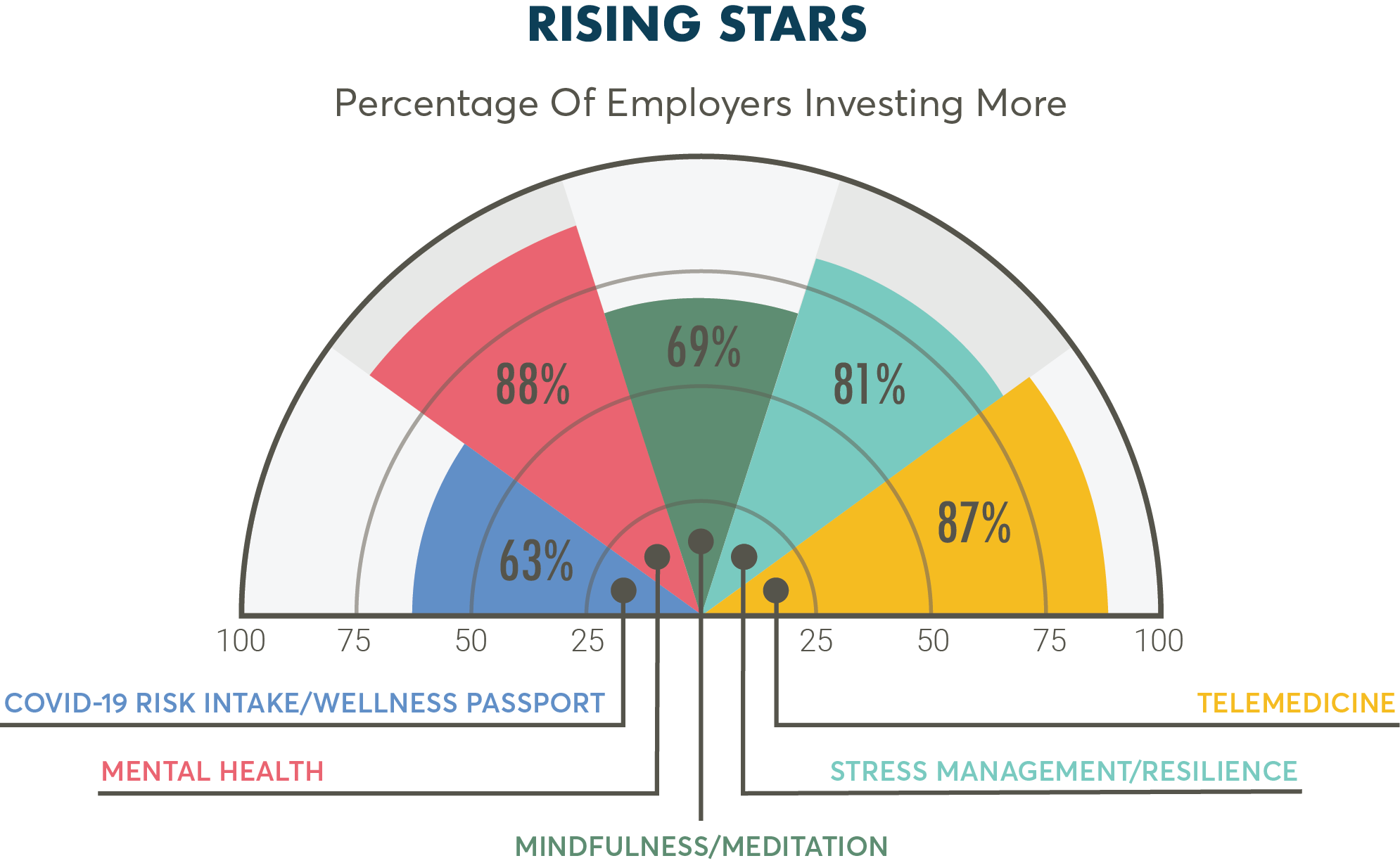How should we think about staff well-being?
A growing number of businesses and educational organizations are promoting well-being (or wellness) among their employees. According to one human resources firm, 48% of employers anticipate adding a well-being initiative by 2023. Another recent survey found that 37% of employers plan to increase their investment in well-being programs.
The figure below shows what well-being initiatives are receiving the most attention, and by extension, how well-being is currently understood.

In addition to these “rising stars,” the report documents 19 other well-being programs where some employers are investing more. These range from offering financial wellness to on-demand fitness classes.
Well-being and work culture
There’s something strikingly common to all these initiatives: they all focus on helping individuals cope with various situations (e.g., stress, financial hardship, medical crises). While many employees will benefit from exercise, healthy diet, access to medical care and mental health supports, there is no acknowledgement of the link between an individual’s well-being and their experiences doing their work.
Might some of the negative psychological symptoms addressed by common wellness initiatives be caused by an unhealthy or ineffective work environment?
Most of us spend a good portion of our waking life “at work.” It is the nature of this work and how it is carried out that is of concern to us, affecting our well-being. Beyond the access to resources and material supports that employment entails (income, health benefits, retirement, and now, wellness programs), how our work unfolds matters to us. How we are treated at work, and how we treat others at work, is related to our well-being.
In discussing the future of work, the philosopher Kwame Anthony Appiah emphasized that work has four important roles. The first two are the most discussed: producing goods and services and providing income. But work, he pointed out, also creates new forms of community. Thus, work can provide us with a sense of purpose. It can become part of our identity.
These psychological and sociological aspects of work are in fact directly related to individual and collective well-being. Changes to how work is undertaken have a profound influence on one’s sense of community and one’s sense of purpose, one’s identity.
Feeling that one is truly making a difference is especially important for social-sector professionals. Creating the conditions for them to do so contributes to their well-being.
Assessing and fostering well-being at work
Unfortunately, common approaches to well-being tend to be reactive. Employees are stressed and overwhelmed, so employers offer them stress management classes. Of course, we can all use a little support sometimes. And wellness initiatives can contribute to a sense of community. But might we reduce unhealthy amounts of work-related stress if we identified its source? What if we improved an organization’s communication processes, its planning and policies, and fostered trust among staff and between staff and administration? These, we believe, are critical to well-being.

This is where our staff well-being assessments help. In addition to providing a detailed assessment of staff well-being, our surveys help leaders identify how organizational culture (e.g., role clarity) affects staff well-being (e.g., feeling overwhelmed). In our experience, it is common for staff reports of “feeling overwhelmed,” for example, to be systematically related to their ratings of the clarity, timeliness and consistency of communication in their organization. Clear, consistent and timely communication supports staff well-being.
When roles are not clear, when one is uncertain who to report to or seek out when there are problems, when one is afraid to share their concerns about how work is going, staff-well being suffers — as does organizational functioning. This is especially true of education and other social-sector organizations.
Our analyses also link staff personality characteristics with the quality of relationships staff have with peers, building administrators, and district leaders. This is important for two reasons:
- staff are often misunderstood because of their personality traits (e.g., shy staff may appear disengaged or arrogant) and;
- different personalities have different needs when it comes to the organization of work (e.g., introverts generally prefer to work alone).
This knowledge can also contribute to fostering better relationships with students.
As with our student well-being assessments and program evaluation services, we use advanced data analysis technologies. Our method of data analysis keeps us focused on patterns at the level of the individual and not averages. Using modern algorithms, this method is both rigorous and transparent. It allows us to see what patterns exist and how many individuals, with what characteristics, match these identified patterns. Importantly, this advance allows us to break free from common survey question types, such as the heavily relied upon (but disliked) “Likert scale” (strongly disagree … strongly agree). Additionally, our surveys encourage staff voice. Staff can offer their views in response to open-ended questions. Responses are subsequently and quickly analyzed using modern qualitative data analysis software.
Finally, the reports we provide are brief, individualized, and actionable. We tailor each report to our client and their context. We focus our attention on the needs, issues, and concerns clients confide in us during our initial meeting, and offer suggestions for what can be improved, and document what is arelady working well.

